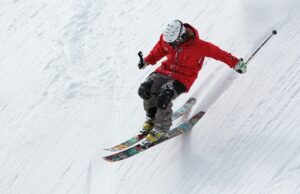Skiing is a great way to get active and enjoy the great outdoors. But it can be tough on your feet.
If you’re new to the sport or just have trouble with blisters in general, here’s all you need to know about this common problem: what causes them, how they form, why they happen more often than not when skiing and how to treat them so they don’t slow down your ability to hit the slopes!
Blistering Speed
Blistering speed is the time it takes for a blister to form. It depends on many factors, including the shape and size of your foot, how well-fitting your ski boots are and whether or not you’re using an outdated binding system.
Blistering speed is also affected by whether or not you’re a beginner skier (beginners tend to have slower blistering speeds) as well as other factors like age and gender (women tend to have faster blistering speeds).
Ski Boot Blister Causes
- Pressure on the foot
- Too-tight boots
- Inadequate break-in period
- Poorly designed boots
- Wearing non-cushioned socks (thin or no cushioning)
Bursting Your Bubble
- Remove the boot.
- Clean the blister with soap and water, or a mild soap if you’re on a backcountry trip.
- Apply an antibiotic ointment to the blister, then cover it with a bandage (and tape if you want to be extra careful).
- Keep it dry!
Preventing Ski Boot Blisters
Preventing blisters is easier than treating them. To avoid blisters, you should:
- Use ski boot liners and wear liner socks (or even a second pair of thin socks) to keep your feet from rubbing against the inside of your boots. If you don’t have any liners or liner socks, use anti-chafing cream on areas where skin might be exposed to friction during skiing.
- Apply a thin layer of petroleum jelly or foot lubricant to your feet before putting on ski boots; this will help keep them dry and prevent blisters from forming in the first place!
Giving Blisters the Boot
- Keep your feet dry. Wet socks are one of the top causes of blisters, so it’s important to make sure you’re wearing dry socks that wick away moisture.
- Wear a sock liner. A thin layer between your skin and the outer layer of clothing will help prevent friction against the ski boots as well as keep sweat from building up inside them and causing irritation or blisters on the tops of your feet.
- Use powder or cream to prevent friction: If possible, apply a powder or cream with talc in it before putting on any socks (this works especially well for preventing shin splints). This will help reduce any potential rubbing between layers while still allowing them to slide smoothly over each other without causing any damage!
- Cover up any existing blisters with bandages: Once there’s already been some damage done by these little wounds popping up around parts like heels or toes–and even sometimes middle parts like insteps–you’ll want coverage right away! Just remember not pop those suckers open; otherwise they’ll get worse instead of better!
Ski Boot Blister Treatment
If you have a blister on the bottom of your foot, it’s important that you remove the boot and sock. Wash the blister with soap and water. Then apply antibiotic ointment, covering any parts of skin that aren’t affected by the blister to prevent infection from spreading.
Covering blisters with bandages helps keep them clean while they heal; if necessary, use an adhesive tape instead of medical tape so as not to irritate surrounding skin or make future removal difficult if needed later on in life (say if you get another blister).
If there is dead skin present around your callus shaver tool before using this method then take off all loose pieces first using a pair of tweezers! This will help prevent injury when shaving away at sensitive areas like feet & hands where there isn’t much fat protecting vital organs such as kidneys etcetera…
Keeping Blisters at Bay
- Keep your feet dry. The best way to prevent blisters is by keeping your feet dry, which means using a good pair of ski socks and wearing ski boots that fit well. If you don’t have the right fit, or if the boots are too tight, there’s a chance that they’ll rub against the skin on the bottom of your foot (or between toes).
- Take time to break in new boots before going skiing with them for the first time; this will help ensure that they won’t cause any problems while on the slopes.* Use foot powder or moleskin as preventive measures against blisters if you know that you’re prone to getting them anyway.* Don’t wear new skis or bindings during practice runs at home – save those until after class when everyone else has already had their turn!
FAQ’s
Yes, it is normal to get blisters on your feet while skiing. Blisters are caused by friction and can be prevented by wearing good quality ski boots that fit properly.
Wear a good pair of socks. The right socks can make all the difference in the world, so don’t skimp on them.
The first thing you can do is make sure that your boots fit properly. If they’re too small or too tight, it can cause friction and rubbing which will lead to blisters. You may also want to try wearing a different style of sock, like one with a cotton heel or toe (instead of synthetic) or even an athletic sock liner instead of traditional white athletic socks. The extra padding could help cushion against the rubbing inside your boot.
Use a boot liner. This can be as simple as putting on a pair of thick wool socks, or you can invest in a specialized liner made with materials like neoprene or other waterproofing technologies.
Conclusion
So, there you have it. We’ve covered the causes of ski boot blisters, how to prevent them and how to treat them. If you’re a skier or snowboarder who suffers from these painful sores, hopefully this article has been helpful in educating you on how best to handle them!



